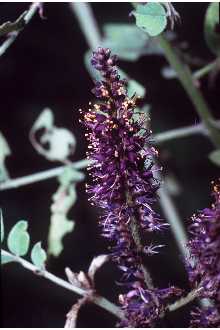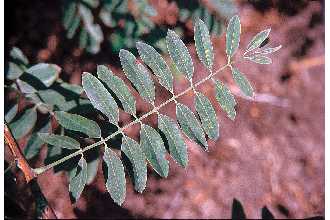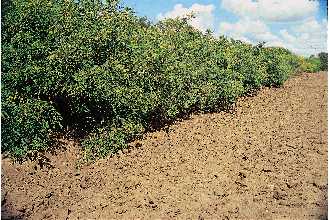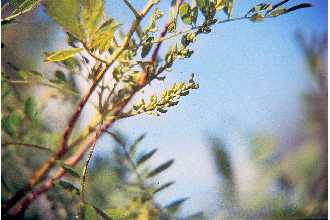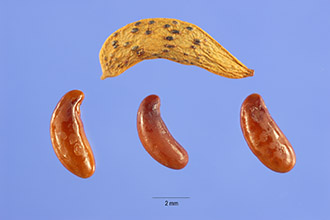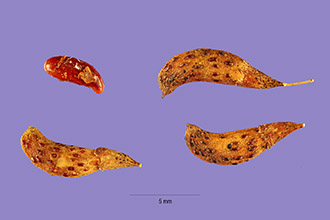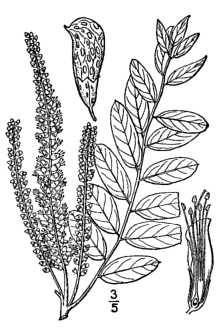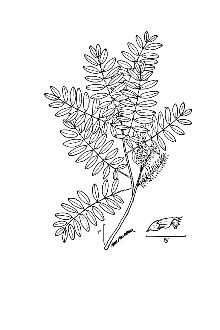Amorpha dewinkeleri Small
Scientific Name: Amorpha dewinkeleri Small
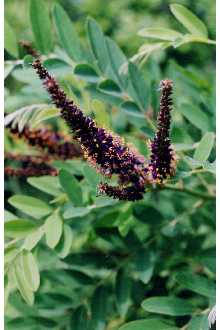
| General Information | |
|---|---|
| Usda Symbol | AMDE3 |
| Group | Dicot |
| Life Cycle | Perennial |
| Growth Habits | Shrub |
| Native Locations | AMDE3 |
Plant Guide
Alternate Names
River-locust, false indigo, indigobush amorpha, indigobush
Uses
Ethnobotanic: Resinous pustules on the plant contain amorpha, a contact and stomachic insecticide that also acts as an insect repellant (Huxley 1992). Desert false indigo also contains some indigo pigment that can be used to make blue dye. Landscape: Amorpha fruticosa is an exotic species that is often planted as an ornamental. This shrub has an extensive root system and is also fairly wind tolerant; it can be planted as a windbreak and also to prevent soil erosion (Huxley 1992). According to Dayton, the early settlers used this shrub as a substitute for true indigo (McMinn 1939).
Status
Please consult the Plants Web site and your State Department of Natural Resources for this plant’s current status, such as, state noxious status, and wetland indicator values, , Use soil moisture sensors to measure the soil moisture of Amorpha dewinkeleri Small.
Description
General: Bean family (Fabaceae). Desert false indigo is a native, deciduous shrub growing between three to ten feet high. The leaves are four to eight inches long, with eleven to twenty-five leaflets, ovate to oblong. This species is highly variable as regards to shape of the leaf and pubescence (The Great Plains Flora Association 1986). The scented flowers are purplish blue with orange anthers and occur in three to six inch long upright spikes in June (Dirr 1997). The fruits are short, smooth or hairy, glandular legumes containing a single smooth brownish seed (Freeman & Schofield 1991). © William S. Justice Botany Department, Smithsonian Institution @ PLANTS Distribution: Desert false indigo occurs in the foothills of the San Bernardino and San Jacinto mountains southward in the lower mountain valleys of San Diego county in the upper Sonoran Life Zone (McMinn 1939). It extends southward to Lower California and eastward to Texas and the Atlantic Coast. This species is also found from Connecticut to Minnesota, south to Florida and Louisiana (Dirr 1997). For current distribution, please consult the Plant profile page for this species on the PLANTS Web site.
Adaptation
Amorpha fruticosa is commonly found on wet ground along rivers, streams, ponds, and ditches and occasionally in open wet woods (Freeman & Schofield 1991). It requires well-drained soil and can grow in nutritionally rich soil. This plant prefers acid, neutral or basic soils. It is adaptable to infertile, dry and sandy soils. Once planted, it remains for life (Dirr 1997). Utilize in dry soil and full sun where precious few plants will prosper.
Establishment
Propagation by Seed: Amorpha fruticosa seeds should be presoaked for twelve hours in warm water and sown in the early spring in a greenhouse. The seeds normally germinate at 20ºC in one to two months. When the seedlings are large enough to handle place them into individual pots and grow them in the greenhouse for their first winter. Plant them in their permanent position in the late spring or early summer.
Management
Desert false indigo has a symbiotic relationship with certain soil bacteria. These bacteria form nodules on the roots and fix atmospheric nitrogen. The growing plant utilizes some of this nitrogen but other plants growing nearby can also use some (Huxley 1992). Cultivars, Improved and Selected Materials (and area of origin) Materials are available through native plant seed sources within its range.
References
Abrams, L. 1944. Illustrated flora of the Pacific States. Vol II. Stanford University Press, Stanford, California. Dirr, M.A. 1997. Dirr’s hardy trees and shrubs: an illustrated encyclopedia. Timber Press, Portland, Oregon. Freeman, C.C. & E.K. Schofield 1991. Roadside wildflowers of the Southern Great Plains. University Press of Kansas, Lawrence, Kansas. Genders, R. 1994. Scented flora of the world. Robert Hale, London. Hylander, C.J. 1954. The MacMillan wildlower book. The MacMillan Company, New York, New York. Huxley, A.1992. The new RHS dictionary of gardening. MacMillian Press, New York, New York. McMinn, H.E. 1939. An illustarted manual of California shrubs. University of California Press, Berkeley, California. Sheat, W.G. 1948. Propagation of trees, shrubs and conifers. MacMillan & Company. Steyermark, J.A. 1963. Flora of Missouri. The Iowa State University Press, Ames, Iowa. The Great Plains Flora Association 1986. Flora of the Great Plains. University Press of Kansas, Lawrence, Kansas.
Plant Traits
Growth Requirements
| Cold Stratification Required | Yes |
|---|---|
| Hedge Tolerance | Medium |
| Hedge Tolerance | Low |
| Frost Free Days, Minimum | 100 |
| Frost Free Days, Minimum | 100 |
| Fire Tolerance | None |
| Fire Tolerance | Low |
| Fertility Requirement | Low |
| Fertility Requirement | Low |
| Drought Tolerance | Medium |
| Drought Tolerance | Medium |
| Cold Stratification Required | Yes |
| Temperature, Minimum (°F) | -38 |
| CaCO3 Tolerance | Medium |
| CaCO3 Tolerance | Low |
| Anaerobic Tolerance | None |
| Anaerobic Tolerance | Medium |
| Adapted to Medium Textured Soils | Yes |
| Adapted to Medium Textured Soils | Yes |
| Adapted to Fine Textured Soils | No |
| Adapted to Fine Textured Soils | No |
| Adapted to Coarse Textured Soils | Yes |
| Adapted to Coarse Textured Soils | Yes |
| Moisture Use | Low |
| Temperature, Minimum (°F) | -38 |
| Shade Tolerance | Intolerant |
| Shade Tolerance | Intolerant |
| Salinity Tolerance | Medium |
| Salinity Tolerance | Low |
| Root Depth, Minimum (inches) | 24 |
| Root Depth, Minimum (inches) | 12 |
| Precipitation, Minimum | 10 |
| Precipitation, Minimum | 10 |
| Precipitation, Maximum | 65 |
| Precipitation, Maximum | 45 |
| Planting Density per Acre, Minim | 700 |
| Planting Density per Acre, Minim | 1200 |
| Planting Density per Acre, Maxim | 2700 |
| Planting Density per Acre, Maxim | 2700 |
| pH, Minimum | 5.0 |
| pH, Minimum | 5.0 |
| pH, Maximum | 8.5 |
| pH, Maximum | 8.5 |
| Moisture Use | High |
Morphology/Physiology
| Active Growth Period | Summer |
|---|---|
| Toxicity | Slight |
| Toxicity | Slight |
| Shape and Orientation | Rounded |
| Fire Resistant | No |
| Foliage Texture | Fine |
| Foliage Texture | Coarse |
| Foliage Porosity Winter | Porous |
| Foliage Porosity Winter | Porous |
| Foliage Porosity Summer | Dense |
| Foliage Porosity Summer | Dense |
| Foliage Color | Yellow-Green |
| Foliage Color | Green |
| Flower Conspicuous | Yes |
| Flower Conspicuous | No |
| Flower Color | Purple |
| Flower Color | Purple |
| Resprout Ability | Yes |
| Fire Resistant | No |
| Fall Conspicuous | Yes |
| Fall Conspicuous | No |
| Coppice Potential | Yes |
| Coppice Potential | Yes |
| C:N Ratio | High |
| C:N Ratio | High |
| Bloat | None |
| Bloat | None |
| Active Growth Period | Spring and Summer |
| Shape and Orientation | Climbing |
| Fruit/Seed Color | Brown |
| Resprout Ability | No |
| Nitrogen Fixation | Medium |
| Nitrogen Fixation | Medium |
| Low Growing Grass | No |
| Low Growing Grass | No |
| Lifespan | Moderate |
| Lifespan | Moderate |
| Leaf Retention | No |
| Leaf Retention | No |
| Known Allelopath | No |
| Known Allelopath | No |
| Height, Mature (feet) | 15.0 |
| Height, Mature (feet) | 15.0 |
| Fruit/Seed Color | Brown |
| Fruit/Seed Conspicuous | No |
| Fruit/Seed Conspicuous | Yes |
| Growth Form | Multiple Stem |
| Growth Form | Multiple Stem |
| Growth Rate | Moderate |
| Growth Rate | Slow |
| Height at 20 Years, Maximum (fee | 6 |
| Height at 20 Years, Maximum (fee | 6 |
Reproduction
| Propagated by Cuttings | Yes |
|---|---|
| Propagated by Seed | Yes |
| Propagated by Seed | Yes |
| Propagated by Sod | No |
| Propagated by Sod | No |
| Propagated by Sprigs | No |
| Propagated by Sprigs | No |
| Propagated by Tubers | No |
| Propagated by Tubers | No |
| Seed per Pound | 52000 |
| Fruit/Seed Period End | Fall |
| Seed per Pound | 77000 |
| Seed Spread Rate | Moderate |
| Seed Spread Rate | Rapid |
| Seedling Vigor | Medium |
| Seedling Vigor | Medium |
| Small Grain | No |
| Small Grain | No |
| Vegetative Spread Rate | None |
| Vegetative Spread Rate | None |
| Propagated by Corm | No |
| Propagated by Cuttings | No |
| Bloom Period | Early Spring |
| Bloom Period | Late Spring |
| Commercial Availability | Routinely Available |
| Commercial Availability | Routinely Available |
| Fruit/Seed Abundance | High |
| Fruit/Seed Abundance | High |
| Fruit/Seed Period Begin | Summer |
| Fruit/Seed Period Begin | Summer |
| Fruit/Seed Period End | Fall |
| Fruit/Seed Persistence | No |
| Propagated by Bare Root | Yes |
| Propagated by Bare Root | Yes |
| Propagated by Bulb | No |
| Propagated by Bulb | No |
| Propagated by Container | Yes |
| Propagated by Container | Yes |
| Propagated by Corm | No |
| Fruit/Seed Persistence | No |
Suitability/Use
| Palatable Browse Animal | Low |
|---|---|
| Palatable Graze Animal | Low |
| Palatable Graze Animal | Low |
| Palatable Human | No |
| Palatable Human | No |
| Post Product | No |
| Post Product | No |
| Protein Potential | Low |
| Protein Potential | Medium |
| Pulpwood Product | No |
| Pulpwood Product | No |
| Veneer Product | No |
| Veneer Product | No |
| Palatable Browse Animal | Low |
| Nursery Stock Product | Yes |
| Nursery Stock Product | No |
| Naval Store Product | No |
| Naval Store Product | No |
| Lumber Product | No |
| Lumber Product | No |
| Fodder Product | No |
| Fodder Product | No |
| Christmas Tree Product | No |
| Christmas Tree Product | No |
| Berry/Nut/Seed Product | No |
| Berry/Nut/Seed Product | No |

